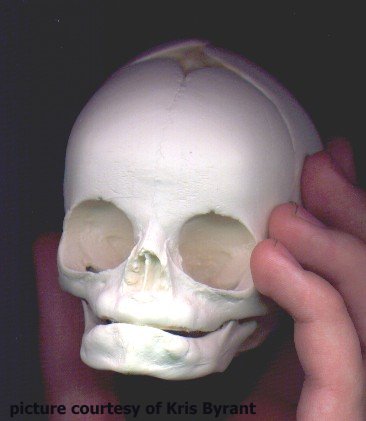Mammal remains
About Skulls
 human fetal skull (Homo sapiens) |
When a young animal dies, the skin rots away and more often than not, the skull will fall apart.
The skull of an adult animal is unlikely to fall apart when the flesh has decayed because the skull sections will have already fused together.
In most cases however, the mandible (jaw) will become disarticulated from the main skull as this is a seperate bone. |
 A newborn kitten and a 3 week old kitten (Felis catus) |
At three weeks old, the kitten skull retains its porosity though the bone is slightly thicker than that of the newborn. Even at three weeks old the skull parts remain unfused. Note that at 3 weeks old the teeth are beginning to emerge.
|
The skulls of both these kittens fell apart during decay and had to be put back together. This was an interesting exercise, one that I would certainly recommended to anyone who is interested in learning about the anatomy of an animal skull. I would, however, recommend a larger animal be used to begin with. A calf or a lamb skull would be ideal
for a first attempt. |
 Adult cat (Felis catus) |
The bones of the adult cat skull are fully fused. The skull does not fall apart during decay, but the mandible will become disarticulate. The mandible of this specimen was never found. In addition to the obvious size difference between the skull of the adult cat and those of the two kittens, you will also notice a minor difference in the shape of the skull particularly at the back. The skull of the adult cat has a ridge at the back of the skull. This is the occiptal ridge. In the kitten skulls, the occipital ridge has not yet formed. Similar differences are also visible amongst other species and their offspring (see skull pictures) |